Early thoughts: Neon Dynasty Limited

Kamigawa: Neon Dynasty has finally arrived. This week I got the chance to dive into Limited. Let’s talk about that this week since it’s what has been my main focus.
The rumors are true—Neon Dynasty is fast and furious. This set has more playable one-mana cards than any set I can remember, making the set interesting and unique.
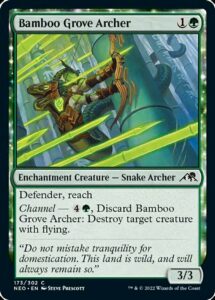
Overall, I think the colors are balanced. Green takes the lead for worst color for me at the moment, but I’ve rarely found myself playing green. Green can slow the game with cards like Bamboo Grove Archer and some potential mana fixing to do some splashy stuff, which I’m on board to try when the opportunity arises.

The rest of the colors are close, but I prefer red right now. While I don’t think red is necessarily the best, some red commons are underrated by the average arena drafter.
I’m consistently getting late Experimental Synthesizers, Simian Slings, and Towashi Songshapers.
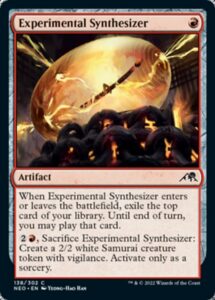
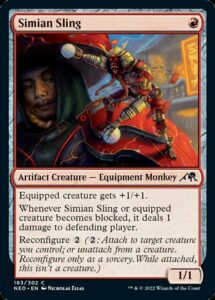

While these cards aren’t first picks, they are quality ways to fill out your deck, and I’m getting them as the 9th-12th picks fairly often.
Even the premium red commons like Voltage Surge and Kami’s Flare are going later than they should as removal in this set is often medium, unless it’s both cheap and instant speed. Ironhoof Boar is another card I like one to two copies of, and they’re basically free.

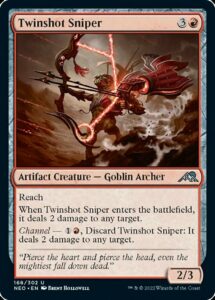
The most important part about red is how deep it is at uncommon. While there are only a couple of mythic uncommons like Twinshot Sniper and Dragonspark Reactor, every single red uncommon is playable in some regard.
I’m getting Rabbit Battery, Kumano Faces of Kazzakan, and Reinforced Ronin’s late especially when I establish myself early in an aggressive red archetype.

One thing to understand about this format is blocking isn’t an option in many cases. You need to get on the battlefield early.
You often want to sequence sagas early because blocking gets tougher as the game proceeds.

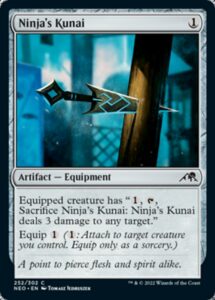
However, if you play a two-drop Saga against a red deck, they can deal tons of damage early and finish you off with alpha attacks and even burn you out with reach, such as Dragonspark Reactor, Kami’s Flare, Ironhoof Boar, or Ninja’s Kunai.
Because Sagas make up a reasonable portion of people’s early plays in many games, cards like Towashi Songshapers can connect once or twice before trading off, which is a huge boon for this kind of two-drop.
Understanding what the colors do in this format and who’s the beatdown is important.

Neon Dynasty has both artifact matters and enchantment matters themes. I’m not a huge fan of loading up with disenchants in this format.
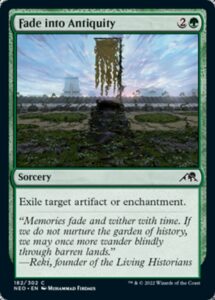
The first copy of Fade to Antiquity is solid, but you can get burnt trading down on mana in this format, especially at sorcery speed.
In most circumstances, I don’t like a second copy of these cards in the main deck because of the potential to be stuck with a dead card combined with mana-efficiency issues.
All my matches of Neon Dynasty limited have been played on Arena Best of One Ladder, so it’s likely my bias toward aggro decks is amplified there with a hand smoother (where the system gives you the best opening hand among three different options).
Flooding can often be mitigated by moving around equipment and reconfiguring creatures to make the best use of them.

I’ve found value engines to be good and cards like Experimental Synthesizer are great, but I’m much lower on cards like Thirst for Knowledge. You want your value to come on board and/or be cheap.

Synthesizer can do all that. I’ll refrain from comparing it to Mulldrifter as I believe it’s worse. I’m wheeling them constantly, which means every time I get one, I’m probably getting more value out of my pick than a first-pick Mulldrifter.
I’m aggressively taking cards that are even slightly worse than Synthesizer and anticipating getting them late.
This will fix itself as time goes on, but right now I’m going to exploit the fact that some people aren’t adjusting and evaluating properly.
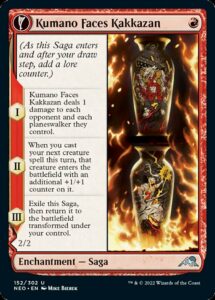
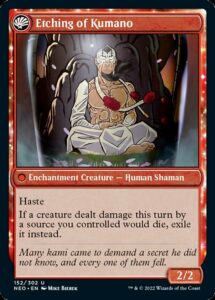
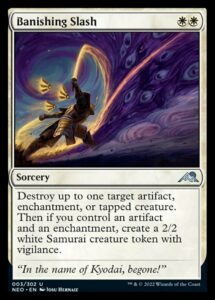
Some uncommons that are going criminally late in many cases are Dragonspark Reactor, Kumano Faces Kakkazan, Generous Visitor, Banishing Slash, Michiko’s Reign of Truth, and the most important two, Patchwork Automaton and Circuit Mender.
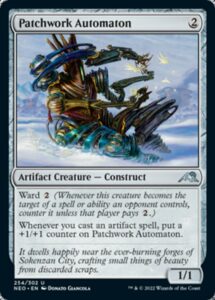

Patchwork Automaton is high impact when taken early, and I’m often willing to take it early and move in. Cutting artifact stuff off early is important, and you’ll reap the rewards later.


Circuit Mender doesn’t go all that late because it fits into any deck, but I think it’s so much better than a card like this has been in the past. It blocks well in this format, incidental life gain is amazing, and it’s also hard to block in this format so ninjitsuing it back has incredible value.
As long as you can offset the tempo loss with cheap removal or a ninjitsu trigger that can affect the battlefield, you’re generally in good shape if you can pull off that interaction.
Below are examples of decks I’ve drafted.


This is a solid UR artifact themed deck. I’d have loved to have a Boar to close with, and I don’t like the Disruption Protocol all that much, but I was short on playables.
I didn’t get a picture of the sideboard, but the only other playable options were another Scraypyard Steelbreaker or something similar.


This is a solid mono red aggro deck. I posted this one on Twitter, but this is close to what an ideal mono red deck with no rares would look like.
I likely should have cut the second four-drop for the fourth Ninja’s Kunai.


This is a traditional UB ninjas deck. Ideally this deck would have another Network Disruptor or two.


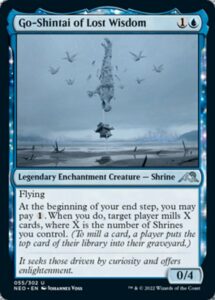

The best thing I’ve found about ninjas is when you’re able to force through ninjas and chain their triggers together. Go-Shintai of Lost Wisdom is an Angelic Wall that can trigger ninjutsu easily early.
I don’t love it, but I wanted more cheap ways to do so.


Lastly we have a BW deck focused loosely on artifacts and enchantments being in play. It mostly was just a deck with decent removal and a good curve. Life of Toshiro Umezawa is one of, if not the best, uncommons in my book.




When you’re able to get a creature on turn two with it, it’s usually lights out for the opponent. I’ve had so many games where I’ve already got one creature killed by it and can’t cast two or three cards in my hand because they’ll just die in chapter two.



Banishing Slash has been nothing short of incredible for me and close to Ravenous Chupacabra levels good.
Such a huge percentage of creatures are enchantments or artifacts, which means they don’t need to be tapped to clear them out of the way, and you’re often going to get a 2/2 vigilance out of the deal.


The fact it hits other enchantments and artifacts is just absurd. This is the kind of disenchant effect you want in your main deck.
All of these decks had seven wins. I didn’t expect seven wins out of any of them because I’m used to a format like Crimson Vow where bomb rares matter a lot. That is not the case in Kamigawa: Neon Dynasty.
Rares can be good but what matters most is drafting a cohesive deck, which is easy because the format is deep.
Next week I’ll likely talk a bit more about Limited. I wanted to get some quick thoughts out about my first few days of the format. I’ll continue to put time in as it develops.
I’m not the biggest fan of Kamigawa: Neon Dynasty Limited. It’s too aggressive for my liking, but I enjoy it more than other fast combat-focused formats, such as triple Ixalan and triple Amonkhet.
Image Copyright: (c) 1995-2020 Wizards of the Coast LLC, All Rights Reserved





